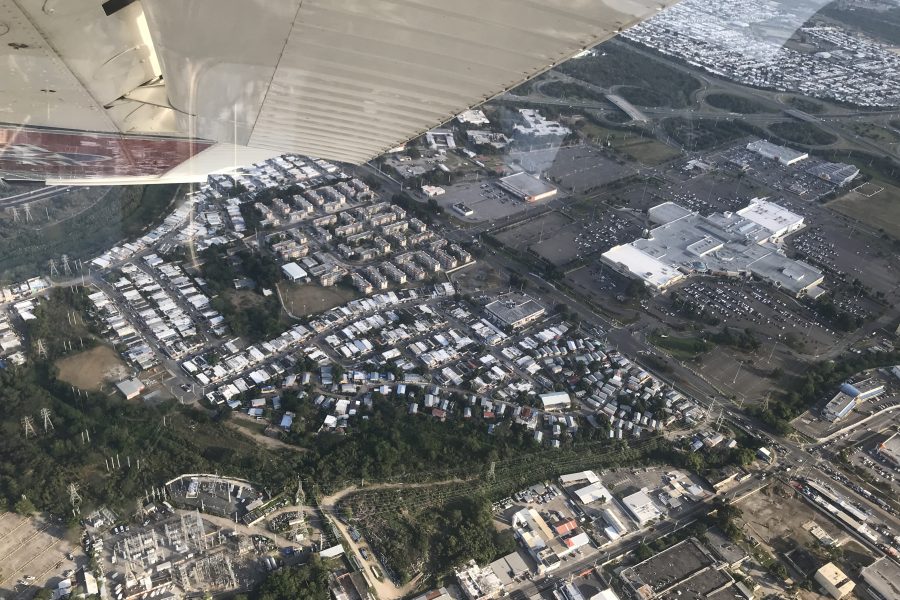Since an ongoing series of earthquakes began to rock Puerto Rico in late December—including a magnitude 5.0 tremor on Feb. 4—Civil Air Patrol has been engaged in relief and recovery efforts, both in the sky and on the ground.
The U.S. Air Force Auxiliary has not only teamed up with the Federal Emergency Management Agency to scope out the extent of the damage, but it has also worked with local organizations to connect citizens in need with basic necessities.
“Civil Air Patrol has a legacy of serving its communities in times of trouble,” Lt. Col. Rick Woolfolk, CAP deputy incident commander for the Puerto Rico response, said in a release. “Our teams are in the field gathering information that will help in the rescue and recovery efforts underway.”

Eyes in the Sky
CAP has supported FEMA since Dec. 28, when a magnitude 4.7 earthquake kicked off the U.S. territory’s current pattern of aftershocks, by gathering footage of earthquake damage from the ground and the sky.
This partnership is enabled through the Defense Support of Civil
Authorities, or DSCA process, through which civilian agencies can request
Defense Department backup for missions that civilians normally carry out.
Early on, CAP used small unmanned aerial systems (sUAS) “equipped with high-resolution photo and video cameras,” to capture footage of spots hand-picked by FEMA, the organization wrote in a release. As of Jan. 29, it had captured over 13,000 drone images for the agency.
CAP also undertook aerial assessment flights in support of the earthquake
response, using Cessnas, which can reach higher altitudes than its UAVs, equipped with externally mounted cameras. These flights tend to “photograph infrastructure, such as roads and bridges, power plants, water treatment facilities, and dams,” CAP Capt. Margot Myers wrote in a release.

On Jan. 20, Air Force Magazine flew with volunteers as they undertook one of these missions. A four-seater Cessna 182 with a WaldoAir camera system attached to its right wing took off from San Juan’s Fernando Luis Ribas Dominicci Airport on a partly cloudy Monday afternoon to capture images of Ponce, Puerto Rico, from the sky.
Once the aircraft reached the target area, it flew around in circles at a 45-degree angle so the camera system could capture the necessary images.
“We were flying looking for something they needed,” CAP Lt. Col. R.E. Jiménez told Air Force Magazine in a post-flight debrief. “What exactly was it? I’m not sure, but I can assume, based [on] when I looked down … that they’re looking for structures that could be damaged. And it’s a lot better to … figure out what’s a problem before it collapses.”

As of Jan. 20, Jiménez—a U.S. Army veteran and former commercial pilot— had flown more than 10 of these missions in support of the earthquake response effort.
In addition to providing FEMA with an invaluable set of eyes in the sky, CAP flights are a fiscally responsible investment for the organization.
According to a 2019 Fact Sheet provided to Air Force Magazine, CAP missions only cost “$120-165 per flying hour,” a price tag chiefly enabled by its utilization of all-volunteer crews.
“It’s every single one of those guys,” Jiménez said in an interview on the airport’s flightline. “They leave their work, sometimes they make like $5,000 a week, and they’re not getting paid.”

Boots on the Ground
CAP’s support of Puerto Rico’s ongoing recovery isn’t just performed midair or from behind a viewfinder.
CAP cadets and adult members have helped local agencies connect internally displaced residents of Puerto Rico with “clothes, food, and supplies,” according to a Jan. 29 CAP release. They also got backup from other chapters from across the territory.
Between 20-40 cadets and senior members reported each day to various distribution points to assist with sorting and distribution of relief items. “With most schools closed because of the disaster, the cadets are keeping busy and serving their communities,” CAP Capt. Elías Román wrote.

Cadets from the Muñiz Air National Guard Base Cadet Squadron, which calls the San Juan suburb of Carolina home, were among those participating in the relief effort.
Members of the squadron photographed more than 50 homes in areas hit hardest by the quakes, which happen to be on the opposite side of the island from their home base, 20-year-old Cadet Lieutenant Col. Carlos Muñoz and 17-year-old Cadet 2nd Lt. Gabriel Fidalgo told Air Force Magazine in a Jan. 18 interview at Muñiz. And when another quake hit while they were already on the ground on a recovery-related mission, they also helped at least one family get out of compromised housing and to a safer place to shelter, they said.
Fidalgo said the experience of reacting to the earthquake was different than responding to Hurricane Maria “since we were going to the place that was really affected while it was still active,” rather than helping to pick up the pieces once the storm had already passed.
“It’s like you’re preparing during the danger,” Muñoz said.

